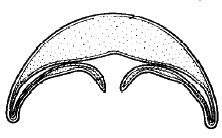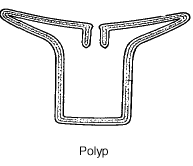 Corals belong to the phylum that includes hydroids, jellyfish,
and sea anemones. All Cnidaria possess the following: radial symmetry,
sac-like body with a central body cavity; body wall containing 3 basic
cell layers; single opening that acts as mouth and anus and surrounded
by food capturing tentacles; possess stinging cells (called nematocysts)
situated on the tentacles.
Corals belong to the phylum that includes hydroids, jellyfish,
and sea anemones. All Cnidaria possess the following: radial symmetry,
sac-like body with a central body cavity; body wall containing 3 basic
cell layers; single opening that acts as mouth and anus and surrounded
by food capturing tentacles; possess stinging cells (called nematocysts)
situated on the tentacles.
Corals usually take on one or two forms, a polyp or a medusa
(see figures). If you take your hands, palms down and open and close your
fingers, that represents a medusa. If you place your hands
palms up and repeat the same motion, this represents a polyp. The
medusa can move freely, like a jellyfish, but the polyp remains stationary
(i.e. corals). This is a good way to demonstrate the relationships
between corals and other cnidarians.
 Corals belong to the Class Anthozoa, along with the sea anenomes,
sea fans, sea pansies, and many others. Since this group can't run
out and get a hamburger, they have to wait for the food to come to the
polyp. The polyp has its tentacles out waiting for debris (goodies
that fall in the water column). This is called suspension feeding.
When a tidbit hits its tentacles the tenacle brings the food toward the
stomach where it is digested (raptorial feeding). Because the corals
are stationary, they have developed different protection strategies using
their skeletons.
Corals belong to the Class Anthozoa, along with the sea anenomes,
sea fans, sea pansies, and many others. Since this group can't run
out and get a hamburger, they have to wait for the food to come to the
polyp. The polyp has its tentacles out waiting for debris (goodies
that fall in the water column). This is called suspension feeding.
When a tidbit hits its tentacles the tenacle brings the food toward the
stomach where it is digested (raptorial feeding). Because the corals
are stationary, they have developed different protection strategies using
their skeletons.
Corals can be solitary or colonial (more than one). Massive
colonial corals have individual polyps that range in size from 1-3 mm in
diameter. The solitary corals can reach up to 25 cm in diameter.
Most people think of corals as big massive structures, but few realize
that these structures are really a colony of the same species who have
built a common skeleton. Because calcium carbonate is more abundant
in warm water, corals tend to build larger structures in warm water.
Corals in colder water tend to be smaller and solitary. The Pacific
coast has small solitary corals that are bright orange which are commonly
mistaken for sea anenomes.
The shape of the skeleton varies from encrusting, spherical masses,
to upright and branching growth forms. There are basically three
taxonomic types of living corals: the cerianthipathanians (including
black and thorny corals), hexacorallians (including stony corals), and
octocorallians (including pipe and blue corals).
The cerianthipatharians have simple unbranched tentacles.
Many of these corals have the fleshy part of the organism on the outside
of the skeleton. Included in this group is the black coral, used
in jewelry making.
The hexacorallians are a diverse group with over 5300 living
species. The group grows septa (supporting "bars" where the organisms
"sits") in multiples of six, hence the derivation of "hexa." Included
in this group are sea anemones and the scleractinia or stony corals.
The stony corals are very common reef builders because they make
a robust and white skeleton that tends to be massive. Also included
are the brain, lettuce, and mushroom corals. The skeleton is composed
of calcium carbonate and is secreted at the base of the polyp. The
base contains radiating calcareous septa that help give the polyp support.
The skeleton provides a substrate on which the polyp attaches with its
fellow corals and protection against fish which like the tender corals
for a snack. The octocorallian corals possess 8 tentacles that are
pennate (looking like a feather). The skeleton is made of calcium
carbonate and/or a horny (organic) material. The calcium carbonate
however is not massive like in the stony coral and therefore not as robust.
The octocorallian include the sea pens, sea fans, red coral, sea pansies,
and pipe corals. This group tends to be more colorful in shades of
red, blue, yellow, and brown.
PROCEDURE:
- Discuss with students the concept of classification.
There are currently six kingdoms that are recognized: Archaea, Bacteria,
Protista, Fungi, Animalia, and Plantae. Each of the kingdoms is divided
into phyla which are groupings of organisms that have similar characteristics.
Each of the phyla are broken into families, families are broken into genera,
and genera are divided into species. Classification is a useful tool
that people use for naming organisms, and for getting a general relationship
of how the organisms are grouped. The way biologists and paleontologists
classify organisms has to do with key characteristics of a group,
whether it is the way an organism eats, moves, or its physical structure.
The higher the taxonomic classification the more likely it will change
as more information is obtained by scientists.
- Since corals may be new to students, discuss what
corals are. If you have a few samples show students the range of structures
that corals have.
- Use the Internet search engines to find more information
on corals.